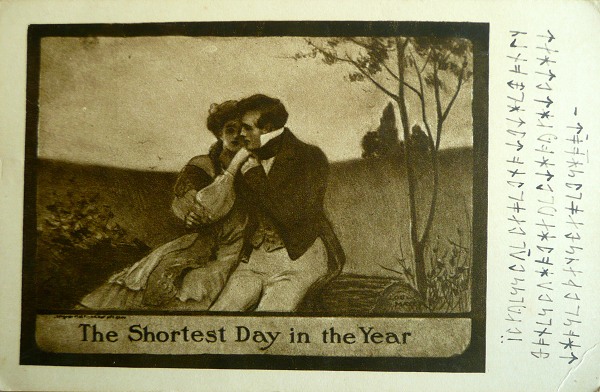Ein US-Professor konnte vor Jahren einige alte verschlüsselte Postkarten knacken. Leider gibt es nur wenige Informationen dazu. Immerhin gibt es eine der Postkarten im Internet – ohne Lösung. Wer kann sie dechiffrieren?
2005 entdeckte die US-Studentin Emily Thielmann bei einer Freundin ein paar alte Postkarten. Diese waren verschlüsselt. Thielmann gab die Karten an den Kryptologie-Experten Professor John Holte vom Gustavus Adolphus College (Minnesota) weiter. Dieser versuchte sie zu lösen.
Wie die Leser von Klausis Krypto Kolumne wissen, sind verschlüsselte Postkarten keine Seltenheit. Vor Aufkommen des Telefons waren Postkarten das mit Abstand beliebteste Kommunikationsmedium, zumal das Porto vergleichsweise günstig war. So mancher Schreiber, der seine Mitmenschen nicht mitlesen lassen wollte, wendete Verschlüsselung an. Eine systematische Übersicht ist mir nicht bekannt, doch die in diesem Blog gemachten Erfahrungen zeigen, dass vor allem Verliebte Postkarten verschlüsselten – in aller Regel mit einfachen Verfahren, die sich heute vergleichsweise leicht entschlüsseln lassen. Am Ende des Artikels finden sich unter “Zum Weiterlesen” einige Beispiele.
Im eingangs genannten Fall stammten die verschlüsselten Postkarten aus der Zeit um 1908. Sie wurden von einem gewissen Rev. Swan Hjalmar Swanson an seine Geliebte geschrieben. Alles, was ich über diese Geschichte weiß, stammt aus einer Veröffentlichung des Gustavus Adolphus College aus dem Jahr 2011. Leider sind die darin enthaltenen Informationen ziemlich dürftig. Ich habe sowohl das College als auch John Holte kontaktiert, doch leider erhielt ich keine Antwort.
Im Artikel sind zwei Seiten einer (derselben?) Postkarte abgebildet. Aus nahe liegenden Gründen konnte ich nicht um Erlaubnis für die Veröffentlichung fragen. Urheberrechtlich sollte ein so altes Dokument allerdings unkritisch sein.
John Holte konnte diese und einige weitere der Postkarten dechiffrieren. Er hatte wohl wenig Mühe damit, da er es mit einer einfachen Buchstabenersetzung zu tun hatte. Über den Klartext und über die weiteren verschlüsselten Postkarten habe ich keine Informationen.
Mich würde nun interessieren: Schafft es jemand, die Verschlüsselung zu knacken? Es sollte relativ einfach sein und ist ja mindestens einmal bereits gelungen. Bessere Scans gibt es hier und hier. Wenn jemand mehr über diese Geschichte weiß, würde es mich ebenfalls interessieren.
Zum Weiterlesen:
Verschlüsselte Postkarte aus dem Jahr 1906 gelöst
Von der NSA entschlüsselt: Zwei verschlüsselte Postkarten aus dem Ersten Weltkrieg
Neuchâtel-Kryptogramm: Eine rätselhafte Postkarte aus dem Jahr 1915
Zwei verschlüsselte Postkarten aus dem Jahr 1912: Wer kann sie knacken?
Follow @KlausSchmeh






Kommentare (10)